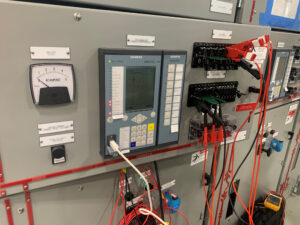Relay Testing Background
 Nearly all complex relays installed today are microprocessor-based. Relays no longer use a disk and magnetic fields to determine the overload condition, instead they rely on complex circuitry, programming, and user input settings to protect the facility. Each relay manufacturer utilizes different programming interfaces and languages and offers varying levels of customization. The various functions utilize an input (current, power, voltage, frequency) with or without a directional element to trigger a user-defined pick-up. Once the function’s pick-up is established, the relay counts down using a user-defined time delay. As the timer expires, the relay will issue the logic tied to the function, which is often a trip command for the current interrupting device or a trip of the lockout relay for a zone of protection. These microprocessor relays operate according to user-defined pick-up values and time delays regardless of the output command.
Nearly all complex relays installed today are microprocessor-based. Relays no longer use a disk and magnetic fields to determine the overload condition, instead they rely on complex circuitry, programming, and user input settings to protect the facility. Each relay manufacturer utilizes different programming interfaces and languages and offers varying levels of customization. The various functions utilize an input (current, power, voltage, frequency) with or without a directional element to trigger a user-defined pick-up. Once the function’s pick-up is established, the relay counts down using a user-defined time delay. As the timer expires, the relay will issue the logic tied to the function, which is often a trip command for the current interrupting device or a trip of the lockout relay for a zone of protection. These microprocessor relays operate according to user-defined pick-up values and time delays regardless of the output command.
Most facilities have an acceptance testing standard requiring relay testing to be performed at final settings per a coordination study. This approach ensures that each relay operates as designed and as expected and provides a high level of confidence that the relay will function at these settings. Under this standard, relays must be retested if the final settings are modified. This often requires a repeat of the test sequence for the modified element. In data center construction, most of the acceptance testing has shifted to the integrator facilities and occurs much earlier in the construction schedule when it is unlikely that the final site-specific settings are available. The cost and schedule impact associated of a full retesting of relays onsite is significant.
Updated Relay Testing Program
To reduce overall testing cost and duration, one of our clients has asked HP&D to modify its acceptance testing specifications to test relays at two points on the pick-up curve and two on the timing curve. This testing regimen considers the pick-up and timing setpoints as two independent variables. To ensure the system is operating as intended, both variables should not be manipulated simultaneously, and therefore, three tests are required. The simplest and recommended format for relay testing is as follows:
|
Test |
Pick-up Setpoint | Time Delay Setpoint |
| Sequence 1 | Setpoint 1 (original) | Setpoint 1 (original) |
| Sequence 2 | Setpoint 1 (original) | Setpoint 2 (tester modified) |
| Sequence 3 | Setpoint 2 (tester modified) | Setpoint 1 |
|
Return settings to as found and complete function test |
||
To implement this test procedure, a standard settings group file is uploaded to each relay at the manufacturer, and all settings installed are considered final for the integrated equipment. Any additional relays not installed as part of an integrated assembly should have the required functions enabled before testing. During testing, the acceptance testing firm will define a protocol to test each of the enabled protection elements at two distinct points for the pick-up setpoint and two distinct points for the timing delay. The two different setpoints should be verifiable; if the pre-programmed time delay is instantaneous, a longer time delay should be selected for the second test where possible. Any secondary settings for complex relay protective elements do not need to be tested outside of the standard settings. For example, a generator protection relay with an ANSI 40 – Loss of Field protection element would not vary the circle 1 and 2 diameter, offset, and directional angle. Similarly, a differential element would be tested by modifying any time delay setpoints but not the operate and restraint elements, to ensure the operate and restrain quantities meet the programmed formulae requirements.
On Budget and On Time
Today’s complex relays offer multiple protection functions in one convenient package. Due to compressed construction timelines on many projects, especially data centers, the existing relay testing protocols need to be modified to reduce testing costs and stay on schedule while still ensuring the relay protection requirements are attained.

